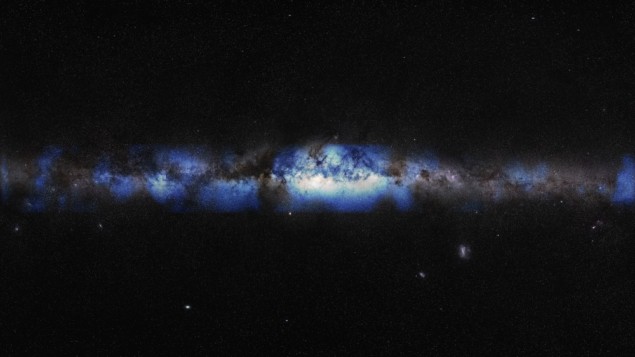
High-energy neutrinos emerging from the Milky Way galaxy have been spotted for the first time. That is according to new findings from the IceCube Neutrino Observatory at the Amundsen–Scott South Pole Station that open a new avenue of multimessenger astronomy by observing the Milky Way galaxy in particles rather than light.
Neutrinos are fundamental particles that have very small masses and barely interact with other matter, but they fill the universe with trillions passing harmlessly through your body every second.
Previously, neutrinos billions of times more energetic than those produced by fusion reactions within our Sun have been detected coming from extragalactic sources such as quasars. However, theory predicts that high-energy neutrinos should also be produced within the Milky Way.
When astronomers look at the plane of our galaxy, they see the Milky Way lit up with gamma-ray emissions that are produced when cosmic rays trapped by our galaxy’s magnetic field collide with atoms in interstellar space. These collisions should also produce high-energy neutrinos.
Researchers have now finally found convincing evidence for these neutrinos by using machine-learning techniques to sift through ten years of data from the IceCube Neutrino Observatory, which includes some 60,000 neutrino events. “[Just like gamma rays], the neutrinos that we observe are distributed throughout the galactic plane,” says Francis Halzen of the University of Wisconsin–Madison, who is IceCube’s principal investigator.
Cascade events
The IceCube detector is formed of a cubic kilometer of ice buried beneath the South Pole and strung through with 5160 optical sensors that watch for flashes of visible light on the rare occasions that a neutrino interacts with a molecule of water-ice. When a neutrino event occurs, the neutrino either leaves an elongated track or a “cascade event” whereby the neutrino’s energy is concentrated in a small, spherical volume within the ice.
When cosmic rays interact with matter in the interstellar medium they produce short-lived pions that quickly decay. “Charged pions decay into the neutrinos detected by IceCube and neutral pions decay into two gamma rays observed by [NASA’s] Fermi [Gamma-ray Space Telescope],” Halzen told Physics World.
The neutrinos had previously gone undetected because they were being drowned out by a background signal of neutrinos and muons caused by cosmic-ray interactions much closer to home, in Earth’s atmosphere. IceCube detects high-energy neutrinos from an active galactic nucleus
This background leaves tracks that enter the detector, whereas the higher energy neutrinos from the Milky Way are more likely to produce cascade events. The machine-learning algorithm developed by IceCube scientists at TU Dortmund University in Germany was able to select only for cascade events, removing much of the local interference and allowing the signal from the Milky Way to stand out.
Although it is more difficult to obtain information about the direction a neutrino has come from in a cascade event, Halzen says that cascade events can be reconstructed with a precision of “five degrees or so”. Although this precludes identifying specific sources of neutrinos in the Milky Way, Halzen says that it is sufficient to observe the radiation pattern from the galaxy and match it to the one observed of gamma rays by the Fermi space telescope.
The next step for the team is to try and identify specific sources of neutrinos in the Milky Way. This could be possible with the revamped IceCube, named Gen2, which will increase the size of the detector area to ten cubic kilometres of ice when it becomes fully operational by 2032.
The findings are published in Science.



